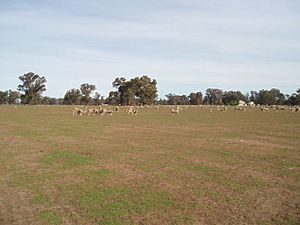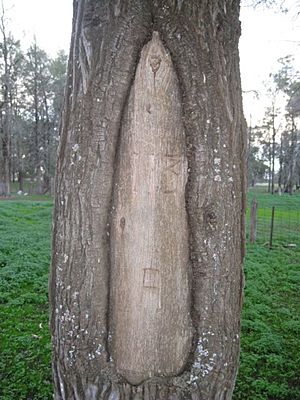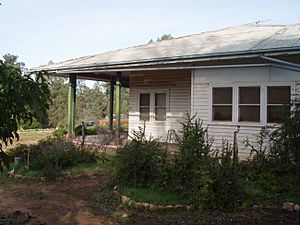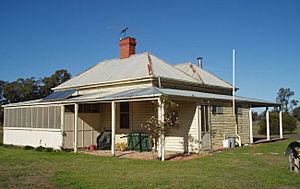Savernake Station facts for kids
Quick facts for kids Savernake Station |
|
|---|---|
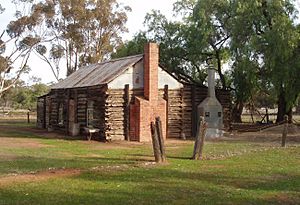
Settlers' hut
|
|
| Location | 2341 Mulwala Road, Savernake, Federation Council, New South Wales, Australia |
| Built | 1862–2012 |
| Architect | Various |
| Official name: Savernake Station and Moveable Heritage; Savernake Homestead; Sloane Family; Mulwala; Rifle collection; Entomology; Photograph and moving image; Aviation; Aboriginal heritage; rural heritage | |
| Type | State heritage (complex / group) |
| Designated | 15 March 2013 |
| Reference no. | 1907 |
| Type | Farm |
| Category | Farming and Grazing |
| Builders | Various |
| Lua error in Module:Location_map at line 420: attempt to index field 'wikibase' (a nil value). | |
Savernake Station is a historic working farm in New South Wales, Australia. It's located near the town of Savernake. This special place was built starting in 1862. It's also known as Savernake Homestead.
Savernake Station is so important that it was added to the New South Wales State Heritage Register in 2013. This means it's protected because of its history. The heritage listing includes the farm's old buildings and many items that have been kept there for a long time. These items tell the story of the Sloane family who have lived and worked on the farm for generations.
Contents
The Story of Savernake Station
First People of the Land
Long ago, the Bangerang people lived on this land. They used the Murray River for travel. They were skilled at making bark canoes. You can still see "scar trees" along the riverbanks today. These are old trees where the Bangerang people carefully cut bark for their canoes.
The Bangerang people found lots of food. They ate shellfish and fish from the river. They also gathered fruits, roots, and nuts from the land. But when Europeans arrived, life changed a lot for the Aboriginal people. Many became sick from new diseases. Some Bangerang people started working on the farms. Men became stockmen, and women helped with housework and childcare.
Early European Settlement
The Savernake area was settled by Europeans as part of the large Riverina region. Early settlers, called "squatters," began moving into this area in the late 1820s. They saw that the land was good for farming and raising animals. As more settlers arrived, the Aboriginal people who lived there were moved from their traditional lands.
The Sloane family's story is central to Savernake Station. Alexander Sloane came to Australia from Scotland in 1849. In 1862, he bought Savernake. He had almost 5,000 sheep there by 1863. In 1864, he also bought Mulwala Station. The Sloanes lived in a simple hut at Mulwala. They added more buildings over time.
In 1867, a big flood caused a lot of damage. The Sloanes moved some buildings to higher ground. This was the start of the Mulwala homestead. The number of sheep grew a lot, and the farm became known for its good sheep. Even during a tough economic time in the 1890s, the Sloanes managed to keep the farm going. Alexander started growing wheat and let other farmers work on his land.
After Alexander passed away in 1907, his sons divided the property. One part of the family continued to live at Mulwala homestead. However, that property has been empty since the 1960s. The Sloane family at Savernake Station has kept many old documents and items from Mulwala. These tell a rich story of the past.
Savernake Station Today
After Alexander Sloane died, his five sons each took a part of the family's land. William Sloane (1860–1933) and his wife, Jeanie Gordon (1875–1942), took over the northern part, which was Savernake. Jeanie was a great photographer. She wrote detailed letters to her family in England about her life on the farm. These letters have been published and give us a glimpse into the past.
Ian Sloane (1903–1986), William and Jeanie's son, was also a talented photographer and filmmaker. He made award-winning films about farm life. One video, "Heritage Farming in Australia," shows how farming was done at Savernake in the 1930s. It shows a huge haystack built in 1935–36. This haystack provided food for animals through four dry years!
Today, Alexander and Ann Sloane are the fourth generation of the family living and working at Savernake Station. The farm is now about 2,000 hectares (4,900 acres). They grow cereals, hay, and raise lambs. They also care for the native plants on their land. They even offer a "Farmstay Cottage" for visitors. The Sloanes are part of a group called "Learning from Farmers." This group helps farmers use sustainable methods. Alexander's sister, Helen Huggins, also owns part of Savernake. She raises sheep and grows cereals.
What You Can See at Savernake
The Land and Nature
Savernake Station is about 2,000 hectares (4,900 acres) today. The Sloane family has used it for farming and raising animals for a very long time. The property still has parts of its original natural environment. It also has many old farm machines.
There's a special forest area with very old trees. Some of these trees are 400 years old! This forest is home to many different kinds of plants and animals. It's a great place for scientists to study nature.
The land was once home to the Pangerang Aboriginal people. You can still find signs of their lives here. There are about six "canoe / scar trees" near a creek. There are also large areas of "middens" (old shell piles) and "oven mounds." These mounds are where the Aboriginal people cooked food. They show that many people lived here long ago.
Historic Buildings
Savernake Station has several old buildings that tell its story:
- 1876 Selector's Hut: This hut shows how early settlers built homes. It's made of wood and mud.
- 1886 Homestead: This is the main house. It has been changed over the years as the family grew. It's now like a private museum.
- 1880s Boundary Rider's Hut: A simple hut for workers who looked after the farm's boundaries.
- 1890s Machinery Shed: This shed holds many old farm tools and horse-drawn vehicles.
- 1902 White Well: A 30-meter deep well dug by hand.
- 1912 Overseer's Cottage: This house for the farm manager is still mostly original.
- 1912 Woolshed and Shearers' Quarters: These buildings show how important sheep farming was. The woolshed has unusual wooden walls. It still has an 1895 steam engine and a 1926 wool press.
Amazing Collections
Savernake Station is famous for its "moveable heritage." This means all the old items, tools, documents, and photos that have been kept there. These collections are like a giant time capsule!
- Farm Equipment: Many old machines are still on the farm where they were used. For example, there's a power plant from 1948 and a petrol pump from 1926. This petrol pump is believed to be the only working original one in Australia!
- Tools and Household Items: The farm has a huge collection of tools and things used in the house since 1862. Some rooms, like the Shearers' Quarters, are set up to show how they looked in the 1930s.
- Family Archives: The Sloane family has kept many diaries, business papers, letters, and magazines. These documents tell the story of the farm and the family's life. They show how farmers dealt with challenges like droughts.
- Photographs and Films: The photo collection is amazing! It shows life on Savernake Station in great detail. Ian Fyfe Sloane, a family member, was an award-winning photographer and filmmaker. His films show farming life in the 1930s. His work is considered a "time capsule" of a past way of life.
- Special Family Collections:
- Rifle Collection: William Sloane, a family ancestor, was a champion shooter. His collection includes rifles, medals, and diaries.
- Aviation History: William Douglas Sloane, another family member, built his own bi-plane in 1912! His items are in a museum nearby.
- Insect Collection: Thomas Gibson Sloane, a great-uncle, was a famous insect expert. His large collection of beetles is now at the CSIRO (Australia's science agency).
- Aboriginal Heritage Items: The collection includes spears, boomerangs, and other items from the local Pangerang tribe. William Sloane was friends with an Aboriginal elder named "Wellington," who taught him how to make boomerangs.
- Family Memorabilia: The family also collected local animals (like taxidermied birds) and other interesting items. There's even a piece of a famous shipwreck!
Condition of the Property
The old machines, collections, and natural forest at Savernake are in good condition. The buildings are also in fair to very good shape, but they need ongoing care. The whole property is a great example of a historic farm.
Why Savernake Station is Important
Savernake Station is very important because it helps us understand what pioneer farming life was like in New South Wales. The Sloane family has continuously farmed this land since 1862.
- History: It shows how the Riverina region was settled. It's still a working farm today, run by the fourth generation of the Sloane family.
- People: The station is linked to many important Sloane family members. These include William Sloane (a champion shooter), Thomas Gibson Sloane (an insect expert), Ian Fyfe Sloane (a famous photographer), and William Douglas Sloane (who built an early airplane). It also has links to the Aboriginal people, especially an elder named Wellington.
- Art and Technology: The farm's collections show how farming technology changed over 150 years. The photographic collection, especially Ian Fyfe Sloane's work, is considered an amazing artistic record of farm life.
- Community: The collections offer a detailed look at a farming family's life and their connections with the local community.
- Research: Savernake Station has a lot of information that can help us learn about Aboriginal history and the history of farming in New South Wales. For example, there are daily rainfall records from 1862 to 1986!
- Rarity: It's rare to find such an old, working farm with so many original buildings and such a complete collection of items. The 400 hectares of undisturbed native woodlands and Aboriginal sites are also very rare.
- Representation: Savernake Station shows how a farm developed in New South Wales from the 1860s to today. The woolshed and shearers' buildings show the importance of sheep farming. The fact that most things are in their original, unrestored condition makes them even more valuable.


